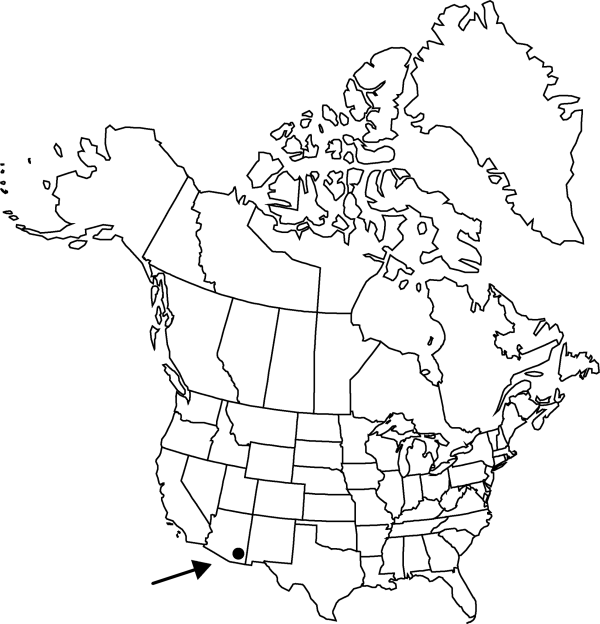familyCactaceae
subfamilyCactaceae subfam. Cactoideae
genusEchinomastus
speciesEchinomastus erectocentrus
Difference between revisions of "Echinomastus erectocentrus var. erectocentrus"
Treatment appears in FNA Volume 4. Treatment on page 194.
FNA>Volume Importer |
imported>Volume Importer |
||
| (7 intermediate revisions by 2 users not shown) | |||
| Line 1: | Line 1: | ||
{{Treatment/ID | {{Treatment/ID | ||
|accepted_name=Echinomastus erectocentrus var. erectocentrus | |accepted_name=Echinomastus erectocentrus var. erectocentrus | ||
| − | |accepted_authority= | + | |accepted_authority= |
|publications= | |publications= | ||
|basionyms= | |basionyms= | ||
| Line 12: | Line 12: | ||
}}<!-- | }}<!-- | ||
| − | --><span class="statement" id="st- | + | --><span class="statement" id="st-undefined" data-properties=""><b>Stems </b>5–34.5 × 6.3–10 cm; ribs 18–21; areoles 8–14 mm apart along ribs. <b>Spines</b> 14–19 per areole, purplish; radial spines 13–18 per areole; abaxial (shortest) radial spine 6–15 × 0.3–0.5 mm; adaxial and lateral (longest) radial spines 9–25 mm; central spines erect, 1(–2) per areole, 12–29 × 0.4–0.9 mm, longest adaxial central spine straight or sometimes curved toward apex of plant; abaxial or solitary central spine 13–15(–29) mm. <b>Flowers</b> 3.9–7 × 4.4–5.2 cm; inner tepals whitish, pale lavender, or very pale pink, proximally olive green, 2.5–2.7 × 0.6–1 cm; stigma lobes red to dark red, papillae red. <b>2n</b> = 22.</span><!-- |
-->{{Treatment/Body | -->{{Treatment/Body | ||
| + | |phenology=Flowering Mar–May. | ||
|habitat=Desert grasslands, low gravelly hills and bajadas, igneous and calcareous substrates | |habitat=Desert grasslands, low gravelly hills and bajadas, igneous and calcareous substrates | ||
|elevation=900-1500 m | |elevation=900-1500 m | ||
|distribution=Ariz. | |distribution=Ariz. | ||
| − | |discussion=<p>Echinomastus erectocentrus var. erectocentrus is in the Center for Plant Conservation’s National Collection of Endangered Plants.</p> | + | |discussion=<p><i>Echinomastus erectocentrus </i>var.<i> erectocentrus</i> is in the Center for Plant Conservation’s National Collection of Endangered Plants.</p> |
|tables= | |tables= | ||
|references= | |references= | ||
| Line 27: | Line 28: | ||
-->{{#Taxon: | -->{{#Taxon: | ||
name=Echinomastus erectocentrus var. erectocentrus | name=Echinomastus erectocentrus var. erectocentrus | ||
| − | + | |authority= | |
| − | |authority= | ||
|rank=variety | |rank=variety | ||
|parent rank=species | |parent rank=species | ||
| Line 34: | Line 34: | ||
|basionyms= | |basionyms= | ||
|family=Cactaceae | |family=Cactaceae | ||
| + | |phenology=Flowering Mar–May. | ||
|habitat=Desert grasslands, low gravelly hills and bajadas, igneous and calcareous substrates | |habitat=Desert grasslands, low gravelly hills and bajadas, igneous and calcareous substrates | ||
|elevation=900-1500 m | |elevation=900-1500 m | ||
| Line 41: | Line 42: | ||
|publication year= | |publication year= | ||
|special status= | |special status= | ||
| − | |source xml=https:// | + | |source xml=https://bitbucket.org/aafc-mbb/fna-data-curation/src/2e0870ddd59836b60bcf96646a41e87ea5a5943a/coarse_grained_fna_xml/V4/V4_364.xml |
|subfamily=Cactaceae subfam. Cactoideae | |subfamily=Cactaceae subfam. Cactoideae | ||
|genus=Echinomastus | |genus=Echinomastus | ||
|species=Echinomastus erectocentrus | |species=Echinomastus erectocentrus | ||
|variety=Echinomastus erectocentrus var. erectocentrus | |variety=Echinomastus erectocentrus var. erectocentrus | ||
| − | |||
| − | |||
| − | |||
| − | |||
| − | |||
| − | |||
| − | |||
| − | |||
| − | |||
| − | |||
| − | |||
| − | |||
| − | |||
| − | |||
| − | |||
| − | |||
| − | |||
| − | |||
| − | |||
| − | |||
| − | |||
| − | |||
| − | |||
| − | |||
| − | |||
| − | |||
| − | |||
| − | |||
}}<!-- | }}<!-- | ||
-->[[Category:Treatment]][[Category:Echinomastus erectocentrus]] | -->[[Category:Treatment]][[Category:Echinomastus erectocentrus]] | ||
Latest revision as of 21:58, 5 November 2020
Stems 5–34.5 × 6.3–10 cm; ribs 18–21; areoles 8–14 mm apart along ribs. Spines 14–19 per areole, purplish; radial spines 13–18 per areole; abaxial (shortest) radial spine 6–15 × 0.3–0.5 mm; adaxial and lateral (longest) radial spines 9–25 mm; central spines erect, 1(–2) per areole, 12–29 × 0.4–0.9 mm, longest adaxial central spine straight or sometimes curved toward apex of plant; abaxial or solitary central spine 13–15(–29) mm. Flowers 3.9–7 × 4.4–5.2 cm; inner tepals whitish, pale lavender, or very pale pink, proximally olive green, 2.5–2.7 × 0.6–1 cm; stigma lobes red to dark red, papillae red. 2n = 22.
Phenology: Flowering Mar–May.
Habitat: Desert grasslands, low gravelly hills and bajadas, igneous and calcareous substrates
Elevation: 900-1500 m
Discussion
Echinomastus erectocentrus var. erectocentrus is in the Center for Plant Conservation’s National Collection of Endangered Plants.
Selected References
None.
Lower Taxa
None.
